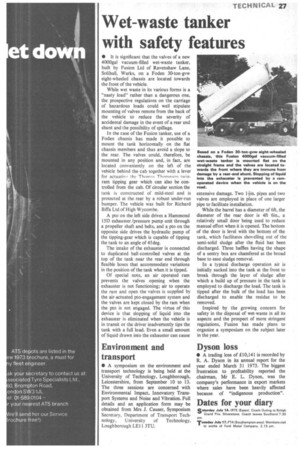Wet-waste tanker with safety features
Page 29

If you've noticed an error in this article please click here to report it so we can fix it.
• It is significant that the valves of a new 4000gal vacuum-filled wet-waste tanker, built by Fusion Ltd of Ravenshaw Lane, Solihull, Warks, on a Foden 30-ton-gvw eight-wheeled chassis are located towards the front of the vehicle.
While wet waste in its various forms is a "nasty load" rather than a dangerous one, the prospective regulations on the carriage of hazardous loads could well stipulate mounting of valves remote from the back of the vehicle to reduce the severity of accidental damage in the event of a rear end shunt and the possibility of spillage.
In the case of the Fusion tanker, use of a Foden chassis has made it possible to mount the tank horizontally on the flat chassis members and thus avoid a slope to the rear. The valves could, therefore, be mounted in any position and, in fact, are located conveniently on the left of the vehicle behind the cab together with a lever for actuatir, thc Thonin,. Thotimsnn twinram tipping gear which can also be controlled from the cab. Of circular section the tank is constructed of mild-steel and is protected at the rear by a robust under-run bumper. The vehicle was built for Richard Bin Ltd of High Wycombe.
A pto on the left side drives a Hammond 15D exhauster/pressure pump unit through a propeller shaft and belts, and a pto on the opposite side drives the hydraulic pump of the tipping-gear which is capable of tipping the tank to an angle of 45deg.
The intake of the exhauster is connected to duplicated ball-controlled valves at the top of the tank near the rear end through flexible hoses that accommodate variations in the position of the tank when it is tipped.
Of special note, an air operated ram prevents the valves opening when the exhauster is not functioning; air to operate the ram and open the valves is supplied by the air-actuated pto-engagement system and the valves are kept closed by the ram when the pto is not engaged. The virtue of this device is that slopping of liquid into the exhauster is eliminated when the vehicle is in transit or the driver inadvertently tips the tank with a full load. Even a small amount of liquid drawn into the exhauster can cause extensive damage. Two 1+in. pipes and two valves are employed in place of one larger pipe to facilitate installation.
While the barrel has a diameter of 6ft, the diameter of the rear door is 4ft 6in., a relatively small door being used to reduce manual effort when it is opened. The bottom of the door is level with the bottom of the tank, which facilitates shovelling out of the semi-solid sludge after the fluid has been discharged. Three baffles having the shape of a sentry box are chamfered at the broad base to ease sludge removal.
In a typical discharge operation air is initially sucked into the tank at the front to break through the layer of sludge after which a build up of pressure in the tank is employed to discharge the load. The tank is tipped after the bulk of the load has been discharged to enable the residue to be removed.
Inspired by the growing concern for safety in the disposal of wet-waste in all its aspects and the prospect of more stringent regulations, Fusion has made plans to organize a symposium on the subject later in the year.
































































































